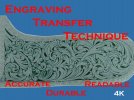BBennett
Member
- Joined
- Feb 18, 2012
- Messages
- 21
Recently, I needed a much better transfer technique for a Perazzi project.
It had to be very accurate, very durable and very readable.
My design was so complicated that old transfer methods just kept me getting lost
in the maze. Bet you know how that feels.
I have posted the instructional video. to YouTube.
The name is Engraving Transfer Technique. (Go Figure)
The link is:
I sincerely believe it could be valuable to you.
Please check it out.
I truly want to share it with everyone.
It made my life much easier.
Good Luck!
Bill
It had to be very accurate, very durable and very readable.
My design was so complicated that old transfer methods just kept me getting lost
in the maze. Bet you know how that feels.
I have posted the instructional video. to YouTube.
The name is Engraving Transfer Technique. (Go Figure)
The link is:
I sincerely believe it could be valuable to you.
Please check it out.
I truly want to share it with everyone.
It made my life much easier.
Good Luck!
Bill







